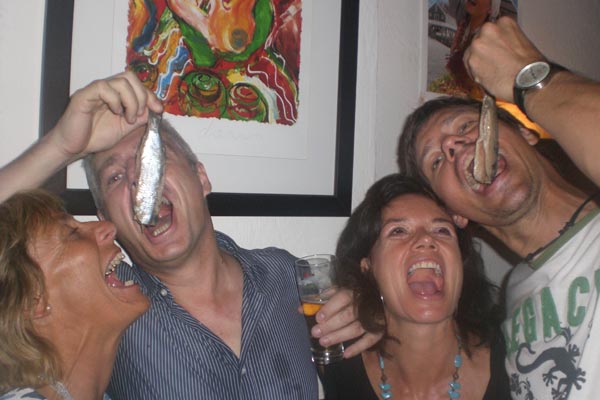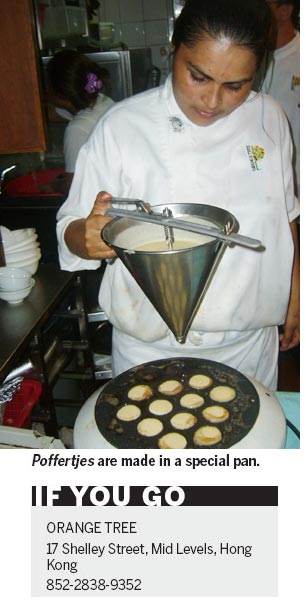Sense of herring
 |
|
The Herring Party is held at the Dutch restaurant Orange Tree on an annual basis. Photos by Donna Mah / For China Daily |
The herring season has just ended in Scheveningen, a coastal city in the Netherlands. But it's not too late to sample some of the creamy-textured fish. Donna Mah reports in Hong Kong.
Vlaggetjesdag (Flag Day) in Scheveningen, a coastal city in the Netherlands, marks the start of herring season for the Dutch. On the Thursday before Flag Day (a different day each year, yet always on a Saturday), the much anticipated first barrel of salted herring, Hollandse Nieuwe, is auctioned off for charity. The fat herrings in the barrel are cleaned, packed in salt, allowed to ripen for a few days, and are ready to be eaten.
"Flag Day in Scheveningen was made official in 1947. Every year we wait for the Hollandse Nieuwe. Every year, this is always front-page news when it reaches the media," says Jacqueline Baud, general manager, Dutch Chamber of Commerce in Hong Kong.
The official opening of the season in Scheveningen is called Flag Day because the fishing boats are decorated with many small flags for the event.
Fishermen in Scheveningen were not allowed to gut caught herring in the 18th century as a monopoly was held by the cities along the river Meuse. Therefore, it was not until the middle of the 19th century that the Scheveningen fishermen started to fish for herring. On May 10, 1947, the arrival of the boats was referred to as "Vlaggetjesdag" for the first time in the press.
Referred to by many as Dutch sushi or sashimi, the distinctive flavor and soft texture of the delicacy is not for everyone.
After the herring have been cleaned and the heads removed, the pancreas is left in the fish so that the pancreatic enzymes can help provide the special flavor to the fish as they ripen.

The fish is traditionally eaten whole (minus the head) with chopped raw onion and pickles. To eat the fishy treat, you hold the fish by the tail, roll it in the onions and pickles (I personally prefer onions only), raise the fish in the air, slowly lower it into your mouth, and take a bite. Lekker! (Delicious!)
For Dutch communities all over the world, if they are able to bring in the herring during the season, an annual herring party is held.
In Hong Kong, where a reported 6,000 Dutch citizens reside in the city, the herring party is usually held in June at the Orange Tree, the only Dutch restaurant in town. This very successful and well-attended event was held on June 21 this year.
Baud tells me that, "The Dutch chamber organizes the Herring Party together with the Orange Tree restaurant on an annual basis. This year we hit a record of welcoming 140 guests who ate 300-plus herrings together!"
That's an average of more than two herrings per person, but one guest confessed that he had eaten six and actually didn't feel so well because of his over enthusiastic response to all that herring. Baud says that it is, "best to combine herrings with some strong liquor (jenever [Dutch gin] or vodka). It's similar to combining sushi with sake."
For the event in Hong Kong, not only are there lots of herring being served, but the jenever bottles were also constantly being replenished. A variety of Dutch snacks were also provided in seemingly endless quantities.
It's not that the party goers want to overindulge, but for many, this event makes them feel "more Dutch" than when they are in the Netherlands, so they end up eating and drinking more than they normally would.
The Dutch know how to enjoy a good party and they were eating bitterballen (deep fried creamy veal balls) with mustard, frikandel speciaal (deep fried Dutch sausages covered in mayonnaise, curry ketchup, and chopped raw onion), platters of Dutch cheese with grapes and walnuts, tartaar (minced raw beef patties), crispy hot french fries with mayonnaise and satay (peanut) sauce, and poffertjes (small pancakes covered in butter and dusted with icing sugar), as well as drinking copious amounts of jenever, wine and beer.
Everyone was in high spirits and conversations flowed easily. The room filled with happy smiles and laughter, which spilled out onto the outdoor area next to the world's longest outdoor escalator.
In the Netherlands, many of these traditional goodies can be found in snack shops, some with walls of self-service dispensers.
Made up of many small glass cubicles, each one houses a warm deep-fried snack. Once the correct amount of money is inserted into the machine, the door of the cubicle can be opened, and the piping hot small bites can be enjoyed.
For those who have not sampled the fish, that are eaten from mid-May to mid-June, the herrings have more than 15 percent fat as they fatten up to prepare to lay their eggs.
The texture of the fish is very creamy and rich. I don't think I can compare the taste and texture to anything I've had before but, for some reason, the herring reminds me of durian.
They taste nothing alike, but durian has a very distinctive flavor, a creamy texture and a strong smell. (Some people say the smell is like something that has definitely gone off and is rotting.) I love eating durian, and I love eating Dutch herring. I don't recommend eating the two together though.
Herring can also be prepared using other traditional methods, such as pickling in vinegar or smoking. When herring is smoked, it turns red and is said to have been used to throw bloodhounds off the trail of fugitives in the old days. This is why, to this day, when a decoy is used to detract from something, it is called a "red herring".
Contact the writer at sundayed@chinadaily.com.cn.
















